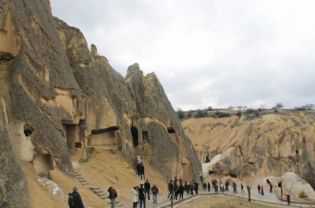The historical region of Cappadocia, in Central Anatolia , Turkey, is a popular name in the world of tourism, and most people link it to the plateau of rock that is situated 1,000 meters above sea level in Nevsehir Province . But the outer beauty of the rock isn’t the only attraction — caves, tunneled like giant ant colonies into the rock, have been home to local people for thousands of years, and now welcome visitors, eager for an experience from the past.

The geological condition in Cappadocia has turned the area into a plateau of soft rock, called tufa . For nine million years, water and air have eroded the tufa so these lines of rocky mountains form cliffs and spectacular shapes and structures featuring conical rock pillars, mushrooms, caps, minarets and chimneys with the caves inside. When it’s moist, residents can easily chisel and shape the tufa into cave houses — the signature tourism draw of the destination.
It was afternoon when I arrived in Cappadocia’s small town of Urgup . The sky was clear blue, but it was freezing outside. My car dropped me off in front of a door that led to a three-story house of limestone rock — the place I had ventured so far to visit.
“Welcome! Sorry, but your room is not ready yet. Please go upstairs for some tea,” Mehmet, the hotel caretaker, greeted me.
Leaving my luggage behind, I stepped on the big stone stairways leading to the third floor. The passageway was narrow and on each level there were four to five rooms all featuring windows cut from the stone. Upon entering the living room, I was surprised by the stunning view of the neighborhood of cave houses. I saw a lot of holes on the coned hilly rock alongside normal houses and from a distance, it looked like a bird nest.
Quite different from what I had imagined prior to arriving in Cappadocia, the cave room I stayed in was equipped with an old-fashioned — but effective — heater, electricity and hot and cold running water in the bathroom. It is a far cry from the cave houses of the Flintstone Age. Instead, the decorations, bedcover and carpet in the 35-square-meter hotel room called to mind the Ottoman time. And at night, nothing could beat the complete silence it offered, leading to a great sleep.
The cave houses have been inhabited by local families for generations. The Hittites , the ancient people of Central Anatolia, first built the structures as early as the 18th century B.C . The terrain offered protection from invaders, animals and weather conditions — the temperature inside stays warm during the winter and cool in summer.
Different civilizations like the Assyrians, Persians, Greeks and Armenians settled in Cappadocia over the years. During the Roman Byzantine period, Cappadocia cave houses served as hiding places for persecuted Christians.
Later, monks built cave chapels, which can now be visited in the Dervent Valley and Goreme Open Air Museum . In the 12th century, the Turkish invaded Cappadocia and made it part of their nation.
While modern civilization just started to build bunkers in the last 60 years, thousands of years ago the Cappadocians built their own underground cities, most of which are eight levels underground. Cappadocia hosts 36 underground cities, however, only four of them are open to public.
One of the most popular underground cities is Kaymakli, which has been open to the public since 1964. The low, narrow and sloping passage of the four levels open to tourists is lit by lamps.
The first floor of the underground city is used for the stable, a small church with a door made of millstone and a living room. With all the tunnels going different directions inside, it took a while to navigate this floor.
“I myself have been learning by doing this over the last four years,” my guide said. The city’s long, low passage proved challenging to explore, but the experience was worth it.
The second floor is home to the church. The Cappadocians held their religious ceremonies in the underground city to avoid being arrested by Roman soldiers. The city also had built-in traps on each level, like a round stone to block the door and holes in the ceiling to drop spears, in anticipation of Roman raids.
The third floor was largely used for logistics like the kitchen, winery and storage place. The number of storage places in the underground city shows that the facilities could sustain a population of 3,500 people.
While the city is underground, there’s plenty of fresh air. In addition to ventilation shafts, there are also ducts, allowing people to communicate from one floor to another — a kind of ancient intercom.
Urgup is not the only town in Cappadocia where caves have become sanctuaries for hundreds of years — people in towns like Goreme, Uchisar, Ihlara Valley and Cavusin also draw tourists, eager to see cave life. In addition, the growing number of cave houses have been converted into restaurants and hotels, ranging from low-budget to five-star, where travelers can enjoy their stay.
While cave homes may seem primitive, the long-standing structures with plenty to offer modern-day residents make it clear that the Hittites and Cappadocians were highly intelligent people, boosting an advanced civilization for their period of time.
via Exploring Cave Houses and Underground Cities in Turkey | The Jakarta Globe.

Leave a Reply